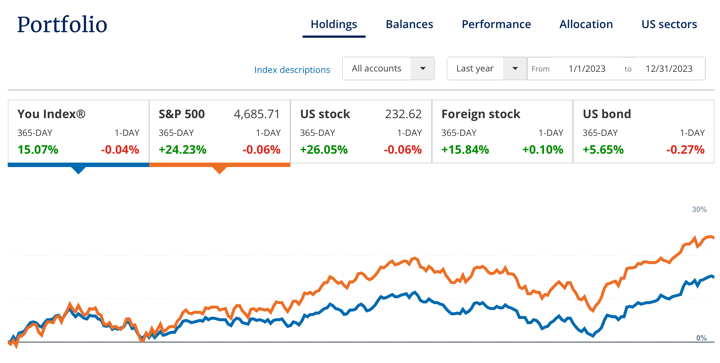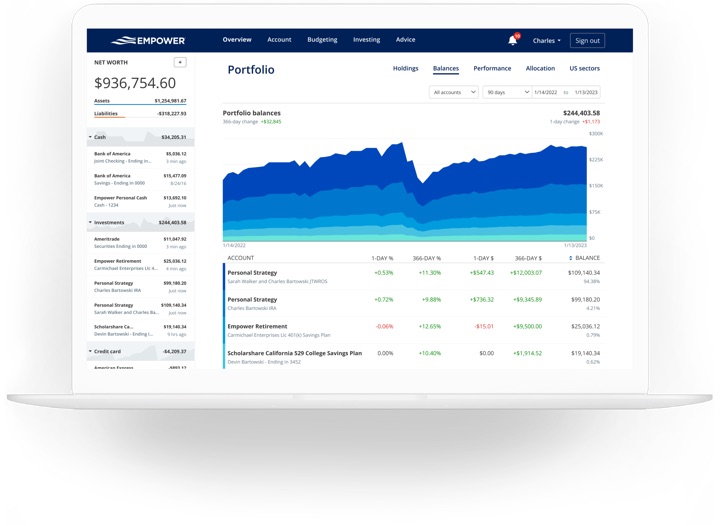Here’s my year-end 2023 update for my investment holdings (published January 2024), including all of our combined 401k/403b/IRAs and taxable brokerage accounts but excluding our primary residence and side portfolio of self-directed investments. Following the concept of skin in the game, the following is not a recommendation, but a sharing of our real-world, imperfect, low-cost, diversified DIY portfolio.
“Never ask anyone for their opinion, forecast, or recommendation. Just ask them what they have in their portfolio.” – Nassim Taleb
How I Track My Portfolio
Here’s how I track my portfolio across multiple brokers and account types. There are limited free advanced options after Morningstar discontinued free access to their portfolio tracker. I use both Empower Personal Dashboard (previously known as Personal Capital) and a custom Google Spreadsheet to track my investment holdings:
- The Empower Personal Dashboard real-time portfolio tracking tools (free) automatically logs into my different accounts, adds up my various balances, tracks my performance, and calculates my overall asset allocation daily. Formerly known as Personal Capital.
- Once a quarter, I also update my manual Google Spreadsheet (free to copy, instructions) because it helps me calculate how much I need in each asset class to rebalance back towards my target asset allocation. I also create a new tab each quarter, so I have an archive of my holdings dating back many years.
2023 Year-End Asset Allocation and YTD Performance
Here are updated performance and asset allocation charts, per the “Holdings” and “Allocation” tabs of my Empower Personal Dashboard.


Humble Portfolio Background. I call this my “Humble Portfolio” because it reminds me to accept the repeated findings that the ability to know when stocks or bonds will outperform is exceedingly rare. Charlie Munger believes that only 5% of professional money managers have the skill required to consistently beat the index averages after costs.
Instead, by paying minimal costs including management fees, transaction spreads, and tax drag, you can essentially guarantee yourself above-average net performance over time.
I own broad, low-cost exposure to productive assets that will provide long-term returns above inflation, distribute income via dividends and interest, and finally offer some historical tendencies to balance each other out. I have faith in the long-term benefit of owning businesses worldwide, as well as the stability of high-quality US Treasury debt. My stock holdings roughly follow the total world market cap breakdown at roughly 60% US and 40% ex-US. I add just a little “spice” to the broad funds with the inclusion of “small value” factor ETFs for US, Developed International, and Emerging Markets stocks as well as diversified real estate exposure through US REITs.
I strongly believe in the importance of knowing WHY you own something. Every asset class will eventually have a low period, and you must have strong faith during these periods to earn those historically high returns. You have to keep owning and buying more stocks through the stock market crashes. You have to maintain and even buy more rental properties during a housing crunch, etc. A good sign is that if prices drop, you’ll want to buy more of that asset instead of less. I don’t have strong faith in the long-term results of commodities, gold, or bitcoin – so I don’t own them.
I do not spend a lot of time backtesting various model portfolios, as I don’t think picking through the details of the recent past will necessarily create superior future returns. You’ll find that whatever model portfolio is popular at the moment just happens to hold the asset class that has been the hottest recently as well.
Find productive assets that you believe in and understand, and just keep buying them through the ups and downs. Mine may be different than yours.
I have settled into a long-term target ratio of roughly 70% stocks and 30% bonds (or 2:1 ratio) within our investment strategy of buy, hold, and occasionally rebalance. My goal has evolved to more of a “perpetual income portfolio” as opposed to the more common “build up a big stash and hope it lasts until I die” portfolio. My target withdrawal rate is 3% or less. Here is a round-number breakdown of my target asset allocation along with my primary ETF holding for each asset class.
- 30% US Total Market (VTI)
- 5% US Small-Cap Value (VBR)
- 20% International Total Market (VXUS)
- 5% International Small-Cap Value (AVDV)
- 10% US Real Estate (REIT) (VNQ)
- 15% US “Regular” Treasury Bonds or FDIC-insured deposits
- 15% US Treasury Inflation-Protected Bonds (or I Savings Bonds)
Performance details. According to Empower, my portfolio is up about 15.1% for 2024. The S&P 500 is up about 25% YTD, while the US Bond index is up around 6%. My overall return lagged the US broad market due to my international stock holdings and bond holdings, but I am still happy with my risk positioning (also see above regarding ups and downs).
Yet again, there was little action on my part this year. I didn’t sell a single share of anything, and that’s how I like it. I did reinvest some dividends and interest into TIPS, but the timing plus the year-end bull run of the US stock market still left me again with a higher stock percentage. Unless something extreme happens, I plan to use my future cashflows to rebalance back into bonds.
I’ll share about more about the income aspect in a separate post.

 The Best Credit Card Bonus Offers – 2025
The Best Credit Card Bonus Offers – 2025 Big List of Free Stocks from Brokerage Apps
Big List of Free Stocks from Brokerage Apps Best Interest Rates on Cash - 2025
Best Interest Rates on Cash - 2025 Free Credit Scores x 3 + Free Credit Monitoring
Free Credit Scores x 3 + Free Credit Monitoring Best No Fee 0% APR Balance Transfer Offers
Best No Fee 0% APR Balance Transfer Offers Little-Known Cellular Data Plans That Can Save Big Money
Little-Known Cellular Data Plans That Can Save Big Money How To Haggle Your Cable or Direct TV Bill
How To Haggle Your Cable or Direct TV Bill Big List of Free Consumer Data Reports (Credit, Rent, Work)
Big List of Free Consumer Data Reports (Credit, Rent, Work)
Why do you invest in international stocks? If we look at returns in last 10 years, it’s not much with vxus while s&p returns are much better. Please explain.
Not a full explanation but past returns don’t predict the future. International brings in a great amount of diversity to a US only portfolio.
https://novelinvestor.com/asset-class-returns/
If you look back longer, you will see the cycles of outperformance by foreign stocks.
https://www.mymoneyblog.com/international-stocks-home-bias.html
I float my holdings with market cap weighting and a small US bias. Will the US continue to outperform forever? It’s possible, and if they do, then I will hold more US stocks.
Typo – 10% US Real Estate (REIT) (VWO) -> that should be VNQ
Thanks, will fix that.
Jan. 8 monday, @ 2024
excellent website, but as for this article, it’s all percentages, ?
so how does one gauge, in dollar terms, especially the total outgo, and total ” income” estimated monthly, or however, ————
Granted, this ” portfolio ” is all theoretical, hypothetical , at this point in time , ……
some way to get a ” real time ” hypothetical ” outgo ” tracked with ” income”
————————–
Thank you , great website, mymoneyblog.com
####
I know people like hard numbers, but I haven’t provided them in a while and I feel the percentages are still useful.
If you assume I started 2023 with a $1,000,000 dollar portfolio, now I have $1,151,000 with no spending. That means I would hold roughly $400,000 in US stocks, $300,000 in international and real estate, and $300,000 in bonds. In terms of income, I spent under 2% of assets as we are still working, with more details to come later.
I’m wondering how old you are, Jonathan because you’re pretty heavy on stock funds. I’m already retired but I do believe in index funds, and we’ve been managing them ourselves for quite a while. I don’t think a financial planner will help much since we would have to pay at least 1% or more.
I’m 45 years old, so balancing the needs of income now but also a hopefully long withdrawal period. I’m also not interested in paying a financial planner 1% of assets per year.
……………….. as it is with me, in terms of 1 % of ” assets” , quite quite….
………………………. great website, mymoneyblog.com
## 1316 1.08 2024 today; Monday.
I manage my own portfolio, too, but go to a fee-only financial advisor about once every two years to get someone else’s opinion and make sure I’m not making any major mistakes. I have found these visits helpful, reassuring and also fun.
Is there a reason you don’t use Fidelity’s portfolio analysis? I have all my brokerage firms connected to Fidelity and it gives me a full view of my entire portfolio analysis.